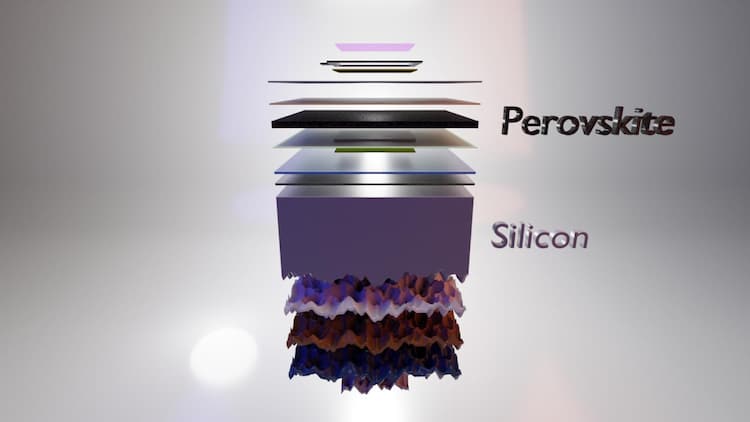Working in tandem A perovskite-on-silicon tandem solar cell. (Courtesy: Oxford PV)”>
Late in 2020, scientists in Germany and Lithuania announced a new milestone in so-called “tandem” solar cells – that is, cells made from two different types of photovoltaic material. Writing in Science, the Helmholtz-Zentrum Berlin/Kaunas University team reported that its perovskite/silicon tandem cell had a photovoltaic conversion efficiency (PCE) of 29.15%, beating out the previous maximum of 26.2% for a tandem cell. The researchers also suggested that their device’s record-breaking efficiency was only the beginning, with plenty of room for tandem cells to improve before running up against theoretical and practical limits.
As it turns out, that prediction was accurate – so accurate, in fact, that the efficiency record lasted only a few months. The jump in PCE wasn’t as big this time – the number to beat is now 29.52%, according to a paper published in Applied Physics Letters – but intriguingly, the new record-holder is not a laboratory prototype. Instead, it’s a commercial product, developed by researchers at a UK-based start-up called Oxford PV and scheduled for installation on residential rooftops sometime in 2022, once the company’s factory in Germany is up and running.
At this point, I should declare an interest. For the past few weeks, I’ve been thinking about getting some solar panels myself, and I was intrigued by the prospect of sticking half-a-dozen record-breakers onto my roof. So I e-mailed Chris Case, the chief technology officer (CTO) at Oxford PV and a co-author of the recent paper, to ask if I should wait until his company’s product becomes available.
His answer was quick and to the point. “Get those PV panels installed!” he wrote back. “You don’t have to wait for ours.” Electricity generated from rooftop photovoltaic (PV) panels is, he explained, already cheaper than the UK’s standard grid price, even at the lower efficiencies typical for monocrystalline silicon cells. “You can’t lose and it’s a step towards saving the planet,” he concluded.
Pragmatic approach
Coming from the company’s CTO, that might sound like a less-than-ringing product endorsement. Yet it fits in well with the pragmatic approach that Case and his co-authors outline in their paper. As of 2020, they note, the world produced only 0.7 TW of solar electricity per year – far below the 14 TW required to meet the International Renewable Energy Agency (IRENA)’s 2050 targets. More efficient solar cells will certainly help close that gap, and Case is keen to emphasize that 29.52% is “nowhere near” the maximum PCE for silicon/perovskite tandem cells. However, the time available for installation is short enough, and the required number of panels large enough, that other considerations also play a role.
One such consideration is the mass per solar cell area of each element in a PV panel’s absorber layers. By plotting this “areal mass density” against the element’s average concentration in the Earth’s crust, it becomes possible to estimate the feasibility of manufacturing large quantities of PV panels from that element. For example, the areal mass density of silicon is the highest of any PV material because silicon isn’t very good at absorbing visible light. Silicon-only cells therefore need a relatively thick absorber layer (at least 150 microns) to function well. However, because silicon is extremely abundant, making up some 27.7% of Earth’s crust by mass, its high areal mass density isn’t an issue for solar PV manufacturers.
Perovskites, in contrast, are complex structures with the chemical formula ABX3 (where A is typically caesium, methylammonium or formamidinium; B is lead or tin; and X is iodine, bromine or chlorine). Their limiting element is iodine, which is vastly less abundant than silicon, making up just 0.000049% of the Earth’s crust. However, Case and colleagues note that tandem cells require half as much iodine as their perovskite-only counterparts. This is partly because the total thickness of the perovskite layer is less, but also because the tandem design allows some of the iodine to be replaced with bromine, which is around six times more abundant. All told, the Oxford PV team argue that while “producers of silicon and perovskite-based technologies would be able to source all the required elements well in advance” of IRENA’s 2050 target, “this would not be achievable at current production levels for any of the other technologies”.

Tandem solar cells break new record
So is it worth holding out for slightly-more-efficient solar panels? For me, the answer will probably depend on a bunch of near-term, non-physics-related factors (including semiconductor supply-chain issues stemming from the coronavirus crisis). Over the next few years, though, it seems likely that the advantages of tandem cells will eat into silicon PV’s current 95% market share, thereby bringing greater efficiency – and an exciting new material – to a rooftop near you.